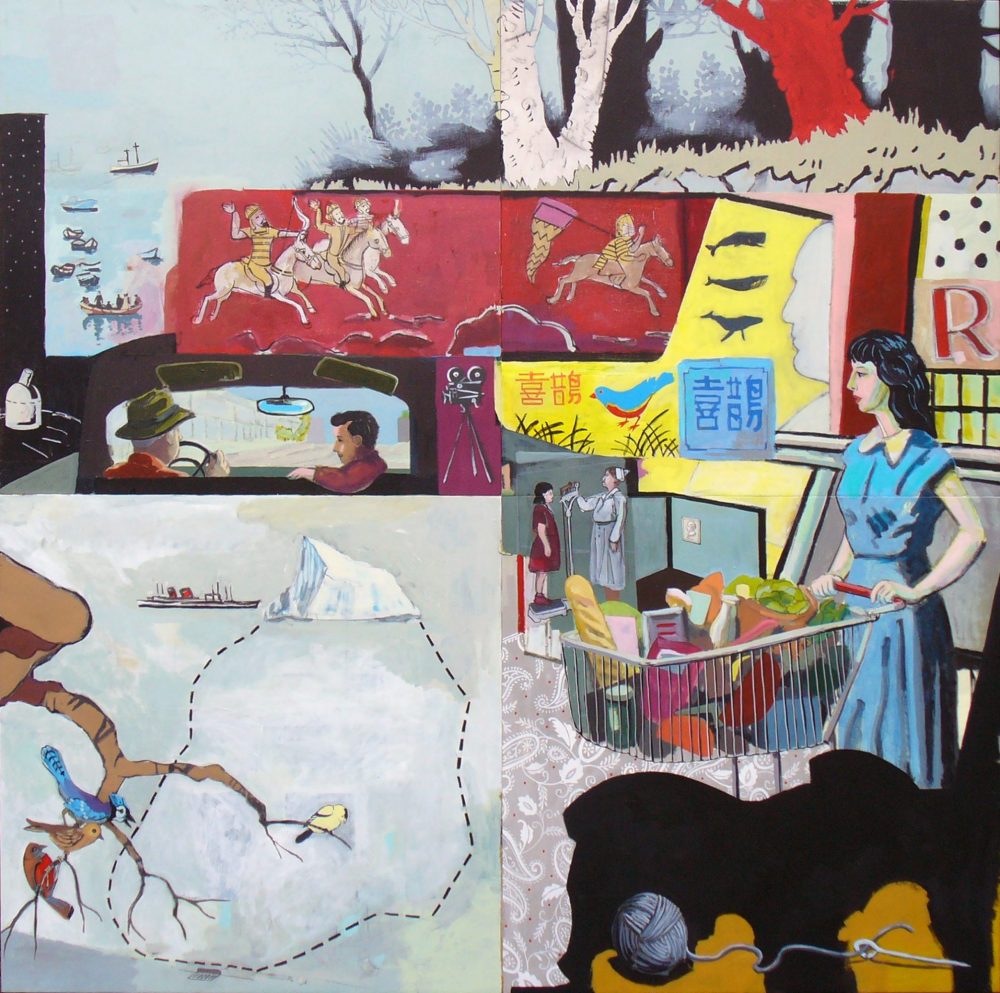You Were Still Here by Chris Knight
- Title: You Were Still Here
- Artist: Chris Knight
- Medium: Acrylic on wood
- Size: 72"h x 72"w
- Added to collection: 2014
- Donor: Purchased by Portland Community College, Rock Creek Campus
- Campus: Rock Creek
- Location: B7/1 Central entrance
A woman pushing a shopping cart full of groceries turns a corner into a vast jumble of pictures made in the cheerful, colorful style one can still find on labels for oatmeal, hot sauce, Chinese herbs, matchbooks. Could these be labels on products the woman has in her shopping cart? If so, she pushes the whole history of the world around, as well as also what appear to be memories from the past midcentury: two men talking in a car observed from the back seat, a nurse weighing a girl on a scales, a film camera on a tripod. The poetic affinities between the images (birds, boats, fish, ships) invite us to bounce between advertisements as between personal and world histories. No conclusions are to be definitively drawn, for, as the image in the lower left implies, all this is but the tip of the iceberg. The title "You Are Still Here," might come as a reminder or reassurance that this Alice has not fallen completely down the rabbit hole, or perhaps this title is addressed to the viewer, who, like the woman in the painting, could lose themselves bouncing around in this pinball game of free association. This acrylic painting from 2012 by Chris Knight on four panels (suggestive of pocket sliding tile game) is an imposing 72x72." Playful in its imagery, it invites the viewer to play along.
What keeps this painting from being a chaotic cacophony of disparate things is the care with which the artist has designed the images: the distribution of blues and reds across the painting as well as patterns and letterforms allow the images space to breathe. Knight has combined emblematic images (like the whale or bird silhouettes suggestive of a child's primer) with more naturalistic images (like the woman). These juxtapositions make for a varied and balanced visual diet. What keeps the painting from feeling glib and arbitrary is the poetic quality of the effect of these juxtapositions, which seem to point to the melancholy at the heart of this ordinary moment of grocery shopping.
"I use narrative elements in my paintings in order to discover and explore the idea that identity and relationships are, in fact, composed of stories: the stories we tell ourselves, the stories we tell others, the stories we choose to remember, the stories we choose to forget. My paintings are filled with allusions to the romance, the caper, and the disaster; filled with bits of text that suggest a children’s primer or lexicon; and filled with characters, tropes, and odd, diorama-like settings. They are filled with story shapes that are familiar and resonant, and suggest that these images are meant to be read. In this respect, you are invited to interpret whether these are moments within a story about leaving or returning, loss or recovery, connection or disconnection, the past or the present, remembering or forgetting. It is my hope that they resonate with you and remind you of your own stories."

